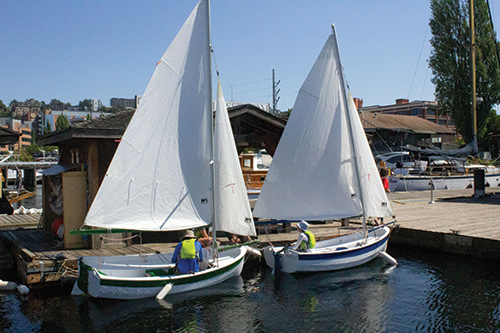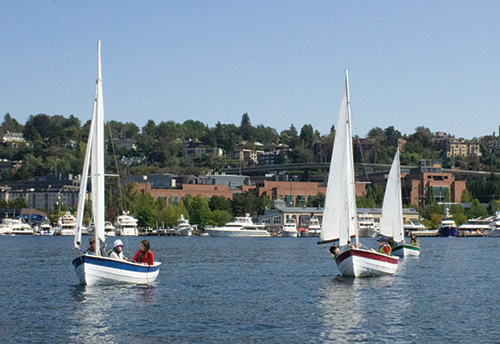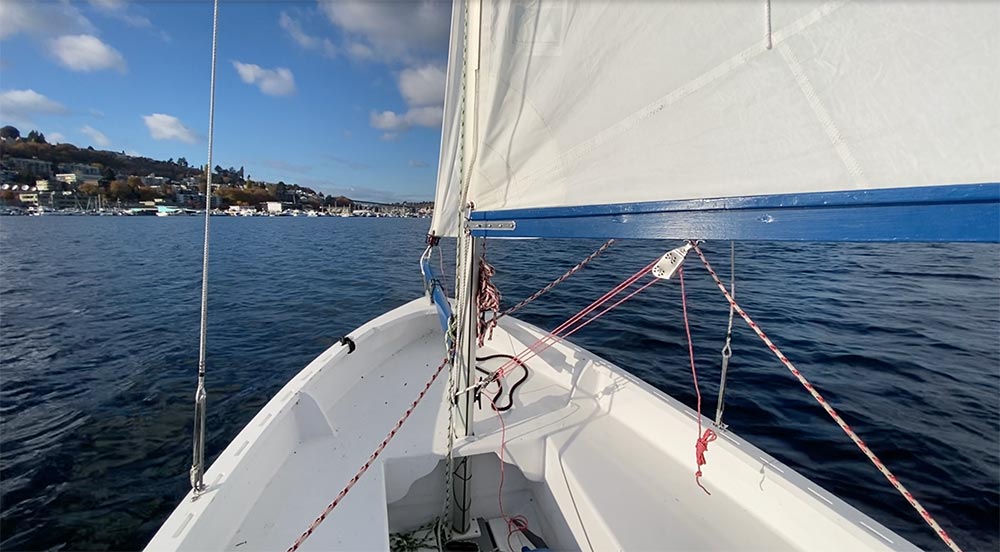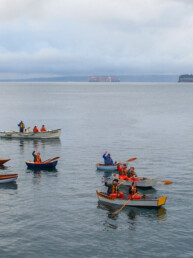A New Sail Training Design, Built By Local High Schoolers
Anyone who spends time on the pleasant waters of Seattle’s Lake Union will be familiar with the always-busy fleet coming and going from the Center for Wooden Boats (CWB) at the south end of the lake. Lessons, rentals, summer camps, and a variety of other programs cast off dock lines on Blanchards, El Toros, Beetle Cats, the recently added RS Fevas, and a variety of interesting rowing craft and one-offs. If there’s a better utilized fleet in the Pacific Northwest, I’d be surprised.
Recently, local boaters may have noticed a different type of boat in the mix. A small sloop-rigged dinghy, bigger than an El Toro, with pleasant lines and a lapstrake appearance. That would be the new Lake Union Swift, a design that’s a collaboration between CWB and Chesapeake Light Craft (CLC). It would be exciting enough to stop there, but then to know that the boats were built at CWB by high school students. Well, that’s next level!
The project has been a couple of years in the making, but has blossomed in 2022 with three Swifts now in service. All three boats are being used for sail training and CWB’s array of educational opportunities for young people.
Since I learned about the Lake Union Swift, I’ve had contact with a number of folks at Center for Wooden Boats, and even got to take a Swift sailing on a sunny afternoon. In short, this Swift is as rewarding a project for students as it is a boat to take for a fun sail.

How The Swift Project Began
Dustin Espey, the Center for Wooden Boats’ Lead Boatwright, first learned about CWB when a family friend recommended it to him shortly before graduating high school in 2016. Already interested in woodworking, he spent two summers renting boats and getting to know the Livery. Thanks to some encouragement from then-CWB-boatwright Bradley and CWB’s Executive Director, Josh Anderson, Dustin went to study traditional boatbuilding at the Landing School near Portland, Maine. He returned to the Pacific Northwest and joined the CWB’s team permanently in 2019.
Shortly after he joined the CWB crew, Dustin was approached by the Youth Programs Director to discuss the possibility of internships for students from Gibson Ek High School in Issaquah. It was through the first summer of this internship program that the Lake Union Swift idea took shape.
The Lake Union Swift is a design-adaptation and build-kit from Annapolis-based Chesapeake Light Craft. Around that time, Owner and Managing Director of CLC, John Harris, visited the South Lake Union campus to help facilitate CWB’s teaching of other CLC kit-build classes. Harris saw all the youth sailing activity at CWB, and heard from the staff about the gap in sail training vessels when kids get a little too big for the 8-foot El Toros.
In collaboration, Harris and the CWB team decided that he should modify an existing design, a lug-rigged row/sail dinghy called the Tenderly, to be used for youth sailing at CWB. As part of the process, Harris invited CWB to name the adapted design. CWB chose to call it the Lake Union Swift after the Swift bird, which is among the fastest birds in level flight and a favorite of longtime CWB supporter, Ross Bond, who was instrumental in helping the build project get off the ground.
It all happened fairly quickly. When school started in the fall of 2019, four Gibson Ek students began building Lake Union Swifts at CWB, with Dustin as the instructor.
The Builds
Dustin says that for most of these kids, “This was their first time being in a shop, let alone a boatshop.” They started out getting acquainted with some basics of tools and woodworking, and taking the first steps toward the builds of two Swift boats in teams of two students.
Like most CLC kits, the Swifts are a stitch-and-glue construction. It’s a more contemporary build style that is accessible and robust for smaller boats — stitch-and-glue kits are available from 8-feet up into the 30-foot range. Computer-aided design and CNC milling both enable ease and success with this construction style. Dustin describes it as “a big, complicated lego set.”
The process begins with “stitching” planks together around a frameset using copper wire. This negates the need for molds, strongbacks, and other forms of bracing. The stitching is loose to start, and gets tighter as the boat takes shape. Like many CLC designs, the Swifts have some overlap between the planks, giving it a lapstrake-style appearance. There’s a little valley in between every stitch — of which there are nearly 500 on the Swifts — which is filled with a bit of thickened epoxy to bind the boats together. Eventually, all the copper wire is cut out, and the boat is left with no fastenings, no metal whatsoever. The real strength and waterproofing comes from the multiple layers of fiberglass that then cover the boat (a step that Dustin says was really unique and fun for the kids).
By the time they got to winter break in 2019, Dustin was impressed with the progress. “We had glued up the frames, and we had the hull mostly set in place, stitched together, and epoxied.” Yet, there was still a lot of tuning up to do, and many more steps in the process; so it was fair to say the builds were still in the early stages.
As 2020 became the pandemic year it was, Gibson Ek canceled all of its internships, and the Swift progress stopped for a while. That summer, Casey Wilkinson, an instructor for some of CWB’s other CLC build classes, began working with a group called Launch 206, which is a program through the Port of Seattle that gets kids into maritime-based trades. They started a third Lake Union Swift, and got it up to a similar stage as the first two.
When the school year of fall 2020 came around, the builds hit a new gear. There were two more Gibson Ek kids, and another joined the project from a Bellevue big-picture school. Dustin enthused, “That was the crew who finished the boats out.”
Dustin says he personally never got satisfaction from the academic side of school. He saw these kids — who don’t have shop classes offered at their schools any longer and are otherwise only given academic options — thrive when given the opportunity to dive deep on a hands-on project and actually produce something. One student, Blake, who was a senior during the first year of the builds, had a lot of varied interests but Dustin says, “wasn’t sure where he was headed after high school.” Blake now works building high-end timber frame deck coverings, utilizing skills, interests, and inspiration that were, in part, developed during the Swift build.

The Boats
With the hulls built, they were nearly ready to head out on the water. The boats come with two rig options — a marconi-rigged sloop with an aluminum mast or the original lug rig — and CWB chose the sloop as a better option for sail training.
To enable the sloop rig, a bowsprit is added, bringing the 10-foot hull’s length overall up to 11-feet. A fractional roller-furling jib attaches to the end of that sprit. The aluminum mast is stepped at the cockpit sole, but passes through the deck, giving it some additional stability.
The cockpit of the Swift has two long seating platforms running fore and aft on port and starboard and extending nearly the full length of the boat, with a generous footwell. Under those seats are buoyancy compartments. While I’d hesitate to call them benches, these seats are flanked by a 6-inch bulwark of the hull, giving the cockpit a comfortable sense of security and enclosure that wouldn’t be present on a sit-on-top style dinghy.
While a person can singlehand the Swift, they can also be sailed by up to four children comfortably. The sail controls are simple — main and jib sheets and boom vang — and within arm’s reach, but could be divided into zones if multiple (small) sailors were aboard. The jib sheet leads and cleats are part of a single, rotating unit that could be trimmed from any angle
For CWB, part of the original appeal was to have more kids on a single boat. But as they thought about it, and the junior instructors began to sail the Swifts, everyone developed an appreciation for how well the boats sail. It may not have been an incentive at the outset of the project, but CWB is now thinking about doing some basic racing on the Swifts, helping young sailors and school groups that don’t already have racing programs. It would be a less intimidating and entry-level counterpart to the more advanced racing CWB now does on the RS Fevas via the US Sailing Siebel Sailing program.

Going Sailing
I got to go out sailing on a Swift on a beautiful November day with breeze between 4 and 9 knots. As I shoved off from the dock along the South Lake shore, I held my breath to see how much of a tightrope I’d be walking in terms of the boat’s hull form stability while I clambered around this dinghy with the weight of several children. In spite of my years on scows and Lasers, I always feel clumsily oversized on most small boats. I was pleasantly surprised. With barely a breath of breeze between the docks, I rocked the boat to make my way to the wind, and was rapidly relieved to discover I wasn’t likely to be swimming, given the Swift’s impressive initial stability.
When I reached the breeze, the boat made me want to play around. The Swift is not the kind of design where only one groove feels good, and I know from previous experience that this fact will make it an enjoyable teaching tool. You don’t have to sail it perfectly for the boat to move or to give you good feedback. I adjusted the sails as I reached out into the shifting puffs.
On such a small boat, there can be limitations to trim and sail shape — a half-inch of sheet ease on the Swift would proportionately be a massive change on a boat five times this size. Nonetheless, I found that some of those nuances were aided by the fact that the boat and its rig aren’t overly stiff. Like other dinghies, pull on the mainsheet and the mast bends, for example. It all worked together, and the boat felt far more like a sailboat than I expected from a row/sail dinghy.
Again in the spirit of experimentation, I jibed over and found myself wanting to goof around with wing-and-wing sailing downwind. Why not? I flipped the main back and found my groove. Fun, and easy.
The relatively high gooseneck placement gives the boom ample cockpit clearance compared to many other dinghies. I still had to duck when tacking or jibing, of course, but I didn’t pull any muscles or get stuck underneath it.
After continuing downwind a bit, I turned upwind. The boat suddenly felt alive. I sheeted in and leaned out over the bulwark in the best puffs of the day. I was genuinely having a great time. Though it is sometimes wise to skip it in a teaching setting, I really missed a tiller extension. I wanted to hike out and push the boat more, and I believe the boat would have liked it! Experimenting on this point of sail, I felt that the Swift was much happier on a slightly cracked close reach than a fully close-hauled mode.
It’s probably not surprising given the various priorities in its design, including being home-build-friendly, but the Swift isn’t likely to outshine modern performance designs on the race course. But truthfully, the Swift was a joy to sail, and it will be a stellar platform for kids to learn and advance as sailors, and for anyone to enjoy a delightful afternoon sail. CWB is right, they will be a riot to race in a one-design setting. With the combination of a secure, stable, and approachable design with controls that translate well to sloops of any size, and its je ne sais quoi is that makes it fun and inspires experimentation — the Swift will surely be a well-loved addition to CWB’s already busy fleet.
There’s a fourth Swift kit in town and plans in development for more students to be welcomed into the world of boatbuilding when they assist with its construction. Don’t be surprised if you start seeing more and more of the Lake Union Swift boats on their namesake waters; and when you do, I bet you’ll want to try sailing one.
Joe Cline is the Managing Editor of 48° North.
Joe Cline
Joe Cline has been the Managing Editor of 48° North since 2014. From his career to his volunteer leadership in the marine industry, from racing sailboats large and small to his discovery of Pacific Northwest cruising —Joe is as sail-smitten as they come. Joe and his wife, Kaylin, have welcomed a couple of beautiful kiddos in the last few years, and he is enjoying fatherhood while still finding time to make a little music and even occasionally go sailing.






